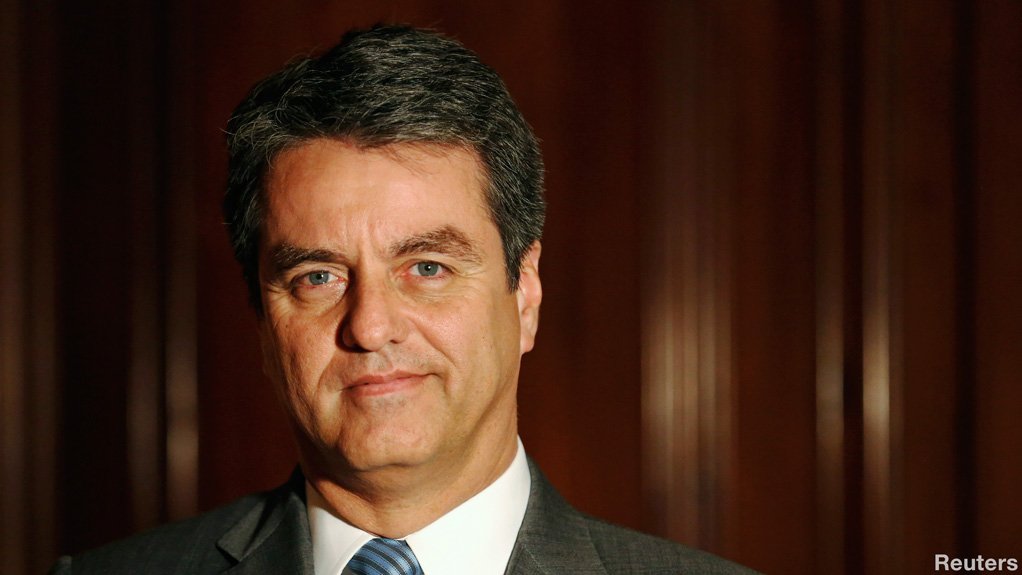World trade will expand by only 1.7% in 2017, the slowest pace since the financial crisis of 2009, a new World Trade Organisation (WTO) report warns. The WTO has also lowered its trade-growth forecast for 2017 to between 1.8% and 3.1%, down from 3.6% previously.
Director-general Roberto Azevêdo describes the slowdown of trade growth as “dramatic” and “serious” and says it should serve as a “wake-up call”.
“It is particularly concerning in the context of growing anti-globalisation sentiment. We need to make sure that this does not translate into misguided policies that could make the situation much worse, not only from the perspective of trade but also for job creation and economic growth and development which are so closely linked to an open trading system,” Azevêdo argues.
The revised estimate is well below the WTO’s April forecast of 2.8% and is attributed to a sharper-than-expected decline in merchandise trade volumes in the first quarter, which fell 1.1% quarter-on-quarter, as measured by the average seasonally-adjusted exports and imports. There was also a smaller-than-anticipated rebound, of 0.3%, in the second quarter.
The slowdown has been driven by weak gross domestic product (GDP) and trade growth in developing economies such as China and Brazil, as well as in North America, which had the strongest import growth of any region in 2014/15, but has since decelerated. The WTO expects real GDP growth of 2.2% for 2016.
WEAKENING TRADE-TO-GDP RATIO
However, the figures also point to a weakening in the relationship between trade and GDP growth.
Trade has typically grown one-and-a-half times faster than GDP, with world merchandise trade volumes having grown about twice as fast as world real GDP at market exchange rates in the 1990s.
“In recent years however, the ratio has slipped towards 1:1, below both the peak of the 1990s and the long-term average. If the revised projection holds, 2016 will be the first time in 15 years that the ratio between trade growth and world GDP has fallen below 1:1.”
Historically, the WTO avers, strong trade growth has been a sign of strong economic growth, as trade has provided a way for developing and emerging economies to grow quickly, while strong import growth has been associated with faster growth in developed countries. However, the increase in the number of systematically important trading countries and the shift in the ratio of trade and GDP growth makes it more difficult to forecast future trade growth.
A recent Peterson Institute for International Economics analysis shows that, at seven years, the world has entered the longest post-war period of relative trade stagnation. "Since 2008, the ratio of world trade to GDP has remained just under 60%. After a quick recovery in 2010 from the sharp fall in 2009, the annual growth of global exports has been stuck at less than 3%, about the same growth rate as world GDP, the authors state.
Meanwhile, in its recent Trade and Development Report, the United Nations Conference on Trade and Development (Unctad) warns that the slowdown of trade is stalling growth in many developing countries, particularly commodity exporters.
“In the absence of concerted recoveries in the developed economies, international trade is in the doldrums for the fifth straight year. To date, protectionist tendencies have been kept in check, but risk surfacing if the real causes of this slowdown are not tackled effectively,” Unctad argues.
The WTO says it is working hard to understand the decline in the ratio of trade growth to GDP growth, which some have attributed to changes in the import content of demand, an absence of trade liberalisation, creeping protectionism, a contraction of global value chains and possibly the increasing role of the digital economy and e-commerce.
“Whatever the cause, the recent run of weak trade and economic growth suggests the need for a better understanding of changing global economic relationships.”
There are some indications, it adds, that trade may be picking up in the second half of 2016. However, the pace of expansion is likely to remain subdued.
“Container port throughput has increased, export orders have risen in the US and nominal trade flows in US dollar terms have stabilised, but numerous risks remain,” the WTO states, adding that the outlook for 2016 and 2017 is affected by a number of uncertainties.
EMAIL THIS ARTICLE SAVE THIS ARTICLE
To subscribe email subscriptions@creamermedia.co.za or click here
To advertise email advertising@creamermedia.co.za or click here











